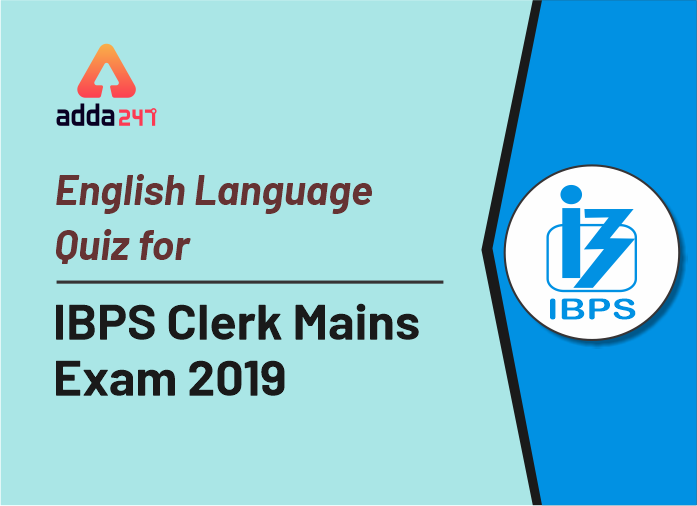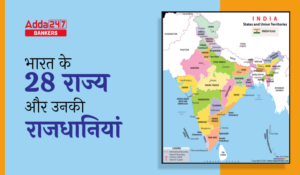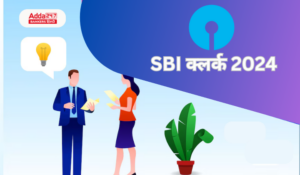English Quiz for IBPS Clerk Mains 29th December
IBPS had conducted the IBPS Clerk Prelims Exam a few weeks ago and the result will be out shortly. Now the next step is to clear the mains exam Thus, the English Language can be an impetus for their success by helping them save crucial time and score good points in lesser time and effort. So, instead of boiling the ocean, try building up a strong vocabulary, an effective knowledge of grammar, and efficient comprehension skills so as to be on the ball to face this particular section. Here is a quiz on English Language being provided by Adda247 to let you practice the best of the latest pattern English Questions for IBPS Clerk Mains Exam.
Directions (1-5): In the following passage, certain words which may be either contextually or grammatically incorrect have been highlighted and numbered. For each highlighted word four alternatives are provided that could replace the highlighted word to make the given sentence both grammatically and contextually correct. Option corresponding to that word will be your answer. If the given word is correct as it is then choose option (e), i.e. ‘No Correction required’ as your answer.
Power (1) trail hike has become par for the course in Punjab, unless elections are around the corner. In May-end this year, the hike had been announced barely a week after the Lok Sabha polls. With the next Assembly elections over two years away, the state government has conveniently decided to make domestic as well as industrial (2) turnover pay even more in 2020. According to the state power regulator, additional revenue requirement of Rs 1,320 crore on account of coal washing charges to be paid to Rajpura Thermal Power Plant and Talwandi Sabo Power Project would be recovered from consumers over the next 12 months. Punjab State Power Corporation Limited (PSPCL) has been bearing the (3) remit of successive governments’ populist commitment of providing free power to farmers, a key vote bank no political party wants to displease. Biting off more than it can chew, the government now owes power subsidy dues to the tune of over Rs 5,000 crore to the PSPCL. Earlier this year, the Punjab and Haryana High Court had questioned the Punjab and Haryana governments on free or subsidised power to rich farmers. The Chief Justice had observed that (4) deadline should be only for the needy, but its burden inevitably fell on the taxpayers. Most of the (5) ensure farmers, which include some influential politicians, have only paid lip service to giving up subsidy on their own.
Q1.
(a) plunge
(b) restriction
(c) tariff
(d) cross
(e) No correction required
(a) plunge
(b) restriction
(c) tariff
(d) cross
(e) No correction required
Q2.
(a) consumers
(b) waste
(c) rivalry
(d) transforms
(e) No correction required
(a) consumers
(b) waste
(c) rivalry
(d) transforms
(e) No correction required
Q3.
(a) defence
(b) pitched
(c) dimension
(d) brunt
(e) No correction required
(a) defence
(b) pitched
(c) dimension
(d) brunt
(e) No correction required
Q4.
(a) discover
(b) subsidy
(c) cause
(d) advantageous
(e) No correction required
(a) discover
(b) subsidy
(c) cause
(d) advantageous
(e) No correction required
Q5.
(a) charge
(b) consumed
(c) affluent
(d) hidden
(e) No correction required
(a) charge
(b) consumed
(c) affluent
(d) hidden
(e) No correction required
Directions (6-10): Read each of the following sentences to find out if there is any grammatical error in it. The error, if any, will be in one part of the sentence. The number of that part is your answer. If there is no error in the statement, then mark option (e) as your answer choice.
Q6. Ram and Rahul used (A) /to practice for almost eight (B) /hours in the auditorium (C) /they are practicing earlier (D)/ No Error
(a) A
(b) B
(c) C
(d) D
(e) None of these.
(a) A
(b) B
(c) C
(d) D
(e) None of these.
Q7. The students were (A) /playing with a ball (B) /and run around when (C)/the accident occurred (D)/ No Error
(a) A
(b) B
(c) C
(d) D
(e) None of these.
(a) A
(b) B
(c) C
(d) D
(e) None of these.
Q8. The United States (A)/ intervened so to (B)/ avoid a hot incident (C) /between the Iraq and Iran (D)/No Error
(a) A
(b) B
(c) C
(d) D
(e) None of these.
(a) A
(b) B
(c) C
(d) D
(e) None of these.
Q9. The policemen started (A)/ firing the crowd with water (B)/ cannon when the striking (C)/ workers became violent (D)/No Error
(a) A
(b) B
(c) C
(d) D
(e) None of these.
(a) A
(b) B
(c) C
(d) D
(e) None of these.
Q10. She was very (A)/ embarrassed when (B)/ her child behaved (C)/ bad in public (D).No Error
(a) A
(b) B
(c) C
(d) D
(e) None of these.
(a) A
(b) B
(c) C
(d) D
(e) None of these.
Directions (11-15): Answer the following questions after rearranging the following sentences into a coherent paragraph.
(A) Afghanistan neither shares borders with India nor is unanimously seen by geographers as part of South Asia.
(B) The first six are geographically located in what is broadly known as South Asia
(C) On India’s initiative based on strategic reasons, the country was made a member of the SAARC over 21 years after its formation.
(D)India shares international borders with eight countries – Pakistan, Bangladesh, Bhutan, Nepal, Sri Lanka, Maldives, Myanmar and China.
(E) India and Afghanistan, however, have a shared history and always had very special political relations.
(F) They are, along with India, original members of the South Asian Association for Regional Cooperation (SAARC) formed in December 1985 in Dhaka.
Q11. What should be the FOURTH sentence after rearrangement?
(a) F
(b) A
(c) B
(d) C
(e) D
(a) F
(b) A
(c) B
(d) C
(e) D
Q12. What should be the THIRD sentence after rearrangement?
(a) D
(b) A
(c) C
(d) B
(e) F
(a) D
(b) A
(c) C
(d) B
(e) F
Q13. What should be the LAST sentence after rearrangement?
(a) F
(b) C
(c) B
(d) E
(e) D
(a) F
(b) C
(c) B
(d) E
(e) D
Q14. What should be the SECOND sentence after rearrangement?
(a) F
(b) B
(c) C
(d) D
(e) E
(a) F
(b) B
(c) C
(d) D
(e) E
Q15. What should be the FIRST sentence after rearrangement?
(a) B
(b) E
(c) D
(d) A
(e) C
(a) B
(b) E
(c) D
(d) A
(e) C
SOLUTIONS:
S1. Ans. (c)
Sol. The correct word to replace the highlighted word in (1) is “tariff”. The sentence thus formed is, “Power (1) tariff hike has become par for the course in Punjab, unless elections are around the corner”.
Sol. The correct word to replace the highlighted word in (1) is “tariff”. The sentence thus formed is, “Power (1) tariff hike has become par for the course in Punjab, unless elections are around the corner”.
S2. Ans. (a)
Sol. The correct word to replace the highlighted word in (2) is “consumers”. The sentence thus formed is, “With the next Assembly elections over two years away, the state government has conveniently decided to make domestic as well as industrial (2) consumers pay even more in 2020”.
Sol. The correct word to replace the highlighted word in (2) is “consumers”. The sentence thus formed is, “With the next Assembly elections over two years away, the state government has conveniently decided to make domestic as well as industrial (2) consumers pay even more in 2020”.
S3. Ans. (d)
Sol. The correct word to replace the highlighted word in (3) is “brunt”. The sentence thus formed is, “Punjab State Power Corporation Limited (PSPCL) has been bearing the (3) brunt of successive governments’ populist commitment of providing free power to farmers, a key vote bank no political party wants to displease”.
Bearing the brunt means: to suffer the main part or force of it.
Sol. The correct word to replace the highlighted word in (3) is “brunt”. The sentence thus formed is, “Punjab State Power Corporation Limited (PSPCL) has been bearing the (3) brunt of successive governments’ populist commitment of providing free power to farmers, a key vote bank no political party wants to displease”.
Bearing the brunt means: to suffer the main part or force of it.
S4. Ans. (b)
Sol. The correct word to replace the highlighted word in (4) is “subsidy”. The sentence thus formed is, “The Chief Justice had observed that (4) subsidy should be only for the needy, but its burden inevitably fell on the taxpayers”.
Sol. The correct word to replace the highlighted word in (4) is “subsidy”. The sentence thus formed is, “The Chief Justice had observed that (4) subsidy should be only for the needy, but its burden inevitably fell on the taxpayers”.
S5. Ans. (c)
Sol. The correct word to replace the highlighted word in (5) is “affluent”. The sentence thus formed is, “Most of the (5) affluent farmers, which include some influential politicians, have only paid lip service to giving up subsidy on their own”.
Sol. The correct word to replace the highlighted word in (5) is “affluent”. The sentence thus formed is, “Most of the (5) affluent farmers, which include some influential politicians, have only paid lip service to giving up subsidy on their own”.
S6. Ans. (d)
Sol. In the last part of the sentence ‘are’ will be replaced by ‘were’. The usage of ‘used to’ clarifies that the sentence is in past tense. This makes our correct answer choice option (d) our answer.
Sol. In the last part of the sentence ‘are’ will be replaced by ‘were’. The usage of ‘used to’ clarifies that the sentence is in past tense. This makes our correct answer choice option (d) our answer.
S7. Ans. (c)
Sol. In the third part of the sentence, the word ‘run’ will be replaced by ‘running’ as the two verb have same verb form when joined with the conjunction.
S8. Ans. (b)
Sol. In the second part of the sentence, we will use ‘as’ before ‘to’. This will make the sentence grammatically correct. The structure of the sentence is ‘so as’.
Sol. In the second part of the sentence, we will use ‘as’ before ‘to’. This will make the sentence grammatically correct. The structure of the sentence is ‘so as’.
S9. Ans. (b)
Sol. In the second part of the sentence we will use ‘on/at’ after firing. This makes the sentence grammatically and contextually correct.
Sol. In the second part of the sentence we will use ‘on/at’ after firing. This makes the sentence grammatically and contextually correct.
S10. Ans. (d)
Sol. In the last part of the sentence, the word ‘bad’ is incorrect as it is an adjective but here we need an adverb. So we will replace ‘badly’. This makes our correct answer choice option (d).
Sol. In the last part of the sentence, the word ‘bad’ is incorrect as it is an adjective but here we need an adverb. So we will replace ‘badly’. This makes our correct answer choice option (d).
S11. Ans. (b)
Sol. The correct sequence is DBFAEC
(D)India shares international borders with eight countries – Pakistan, Bangladesh, Bhutan, Nepal, Sri Lanka, Maldives, Myanmar and China.
(B) The first six are geographically located in what is broadly known as South Asia
(F) They are, along with India, original members of the South Asian Association for Regional Cooperation (SAARC) formed in December 1985 in Dhaka.
(A) Afghanistan neither shares borders with India nor is unanimously seen by geographers as part of South Asia.
(E) India and Afghanistan, however, have a shared history and always had very special political relations.
(C) On India’s initiative based on strategic reasons, the country was made a member of the SAARC over 21 years after its formation.
Sol. The correct sequence is DBFAEC
(D)India shares international borders with eight countries – Pakistan, Bangladesh, Bhutan, Nepal, Sri Lanka, Maldives, Myanmar and China.
(B) The first six are geographically located in what is broadly known as South Asia
(F) They are, along with India, original members of the South Asian Association for Regional Cooperation (SAARC) formed in December 1985 in Dhaka.
(A) Afghanistan neither shares borders with India nor is unanimously seen by geographers as part of South Asia.
(E) India and Afghanistan, however, have a shared history and always had very special political relations.
(C) On India’s initiative based on strategic reasons, the country was made a member of the SAARC over 21 years after its formation.
S12. Ans. (e)
Sol. The correct sequence is DBFAEC
(D)India shares international borders with eight countries – Pakistan, Bangladesh, Bhutan, Nepal, Sri Lanka, Maldives, Myanmar and China.
(B) The first six are geographically located in what is broadly known as South Asia
(F) They are, along with India, original members of the South Asian Association for Regional Cooperation (SAARC) formed in December 1985 in Dhaka.
(A) Afghanistan neither shares borders with India nor is unanimously seen by geographers as part of South Asia.
(E) India and Afghanistan, however, have a shared history and always had very special political relations.
(C) On India’s initiative based on strategic reasons, the country was made a member of the SAARC over 21 years after its formation.
Sol. The correct sequence is DBFAEC
(D)India shares international borders with eight countries – Pakistan, Bangladesh, Bhutan, Nepal, Sri Lanka, Maldives, Myanmar and China.
(B) The first six are geographically located in what is broadly known as South Asia
(F) They are, along with India, original members of the South Asian Association for Regional Cooperation (SAARC) formed in December 1985 in Dhaka.
(A) Afghanistan neither shares borders with India nor is unanimously seen by geographers as part of South Asia.
(E) India and Afghanistan, however, have a shared history and always had very special political relations.
(C) On India’s initiative based on strategic reasons, the country was made a member of the SAARC over 21 years after its formation.
S13. Ans. (b)
Sol. The correct sequence is DBFAEC
(D)India shares international borders with eight countries – Pakistan, Bangladesh, Bhutan, Nepal, Sri Lanka, Maldives, Myanmar and China.
(B) The first six are geographically located in what is broadly known as South Asia
(F) They are, along with India, original members of the South Asian Association for Regional Cooperation (SAARC) formed in December 1985 in Dhaka.
(A) Afghanistan neither shares borders with India nor is unanimously seen by geographers as part of South Asia.
(E) India and Afghanistan, however, have a shared history and always had very special political relations.
(C) On India’s initiative based on strategic reasons, the country was made a member of the SAARC over 21 years after its formation.
Sol. The correct sequence is DBFAEC
(D)India shares international borders with eight countries – Pakistan, Bangladesh, Bhutan, Nepal, Sri Lanka, Maldives, Myanmar and China.
(B) The first six are geographically located in what is broadly known as South Asia
(F) They are, along with India, original members of the South Asian Association for Regional Cooperation (SAARC) formed in December 1985 in Dhaka.
(A) Afghanistan neither shares borders with India nor is unanimously seen by geographers as part of South Asia.
(E) India and Afghanistan, however, have a shared history and always had very special political relations.
(C) On India’s initiative based on strategic reasons, the country was made a member of the SAARC over 21 years after its formation.
S14. Ans. (b)
Sol. The correct sequence is DBFAEC
(D)India shares international borders with eight countries – Pakistan, Bangladesh, Bhutan, Nepal, Sri Lanka, Maldives, Myanmar and China.
(B) The first six are geographically located in what is broadly known as South Asia
(F) They are, along with India, original members of the South Asian Association for Regional Cooperation (SAARC) formed in December 1985 in Dhaka.
(A) Afghanistan neither shares borders with India nor is unanimously seen by geographers as part of South Asia.
(E) India and Afghanistan, however, have a shared history and always had very special political relations.
(C) On India’s initiative based on strategic reasons, the country was made a member of the SAARC over 21 years after its formation.
Sol. The correct sequence is DBFAEC
(D)India shares international borders with eight countries – Pakistan, Bangladesh, Bhutan, Nepal, Sri Lanka, Maldives, Myanmar and China.
(B) The first six are geographically located in what is broadly known as South Asia
(F) They are, along with India, original members of the South Asian Association for Regional Cooperation (SAARC) formed in December 1985 in Dhaka.
(A) Afghanistan neither shares borders with India nor is unanimously seen by geographers as part of South Asia.
(E) India and Afghanistan, however, have a shared history and always had very special political relations.
(C) On India’s initiative based on strategic reasons, the country was made a member of the SAARC over 21 years after its formation.
S15. Ans. (c)
Sol. The correct sequence is DBFAEC
(D)India shares international borders with eight countries – Pakistan, Bangladesh, Bhutan, Nepal, Sri Lanka, Maldives, Myanmar and China.
(B) The first six are geographically located in what is broadly known as South Asia
(F) They are, along with India, original members of the South Asian Association for Regional Cooperation (SAARC) formed in December 1985 in Dhaka.
(A) Afghanistan neither shares borders with India nor is unanimously seen by geographers as part of South Asia.
(E) India and Afghanistan, however, have a shared history and always had very special political relations.
(C) On India’s initiative based on strategic reasons, the country was made a member of the SAARC over 21 years after its formation.
Sol. The correct sequence is DBFAEC
(D)India shares international borders with eight countries – Pakistan, Bangladesh, Bhutan, Nepal, Sri Lanka, Maldives, Myanmar and China.
(B) The first six are geographically located in what is broadly known as South Asia
(F) They are, along with India, original members of the South Asian Association for Regional Cooperation (SAARC) formed in December 1985 in Dhaka.
(A) Afghanistan neither shares borders with India nor is unanimously seen by geographers as part of South Asia.
(E) India and Afghanistan, however, have a shared history and always had very special political relations.
(C) On India’s initiative based on strategic reasons, the country was made a member of the SAARC over 21 years after its formation.
You may also like to read:
- RBI असिस्टेंट सिलेबस , परीक्षा पैटर्न 2020 : प्रीलिम्स एवं मेंस परीक्षा
- English Quiz for Bank Exams, IBPS PO, Clerk, RRB & SBI
All the Best BA’ians for IBPS Clerk Mains 2019!!





 Indian States and Capitals 2024: भा�...
Indian States and Capitals 2024: भा�...
 SBI Clerk 2025 Notification Out - SBI �...
SBI Clerk 2025 Notification Out - SBI �...
 SBI Clerk 2024: क्या फाइ�...
SBI Clerk 2024: क्या फाइ�...

